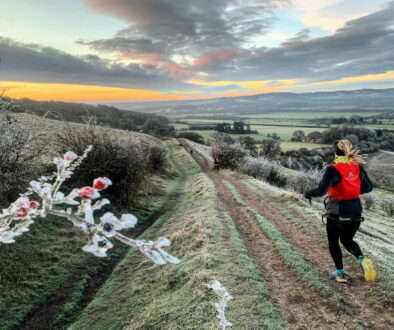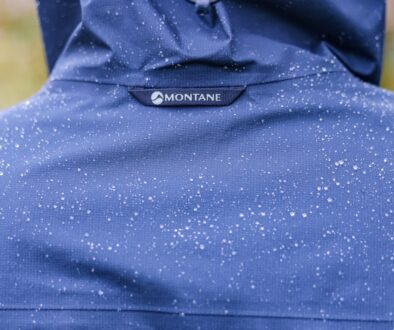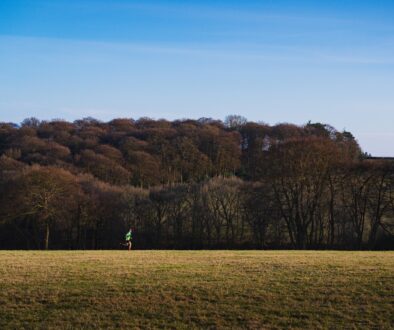What’s the most fun part of trail running? Downhill! What’s the most difficult thing to do well on trails? Downhill! In this deep dive into downhill running we are going to be unpacking some techniques and give you some homework so you can make the most of the adrenaline rush that comes with running downhill.
Most people focus on how much ascent they will be covering over a course. Descending is the most challenging. There are many reasons for this but most surround maintaining control and muscle fatigue. There’s another good reason for focussing more on downhills, and that’s because they are the thrilling part of trails and also where if you are good, you can really pick up speed and in a race environment, places.
The Uphill Myth
From personal experience of racing and running out in the Alps, I still find myself surprised that gains seem to be more notably made on the big descents, with the field of runners spreading out, rather than on the big climbs where differences in fitness sometimes make less of an impact.
The first principle you need to realise, is that no matter how strong you are at uphill running or power hiking, if you are no good on downhills, your opponent in a race who is slower than you on the up, but just fractionally better on the down, will be much quicker than you overall. That’s because running downhill is way more than just fitness, as we will explain here!
What is downhill running?
In its simplest form, the art of running downhill is ‘running as fast as possible on downhill gradients whilst maintaining balance and control’. Pushing maximal speed with just enough balance and control to remain on course. It’s relatively easy to get to grips with control, and it’s also easy to run out of control and fall over while going too fast, but the two working together optimally are what we are looking to achieve, remember the more control, the less speed and the more speed the less control. Remember that running downhill is dangerous! If you don’t get to grips with control, you could really injury yourself, or ultimately run your last trail, so start off slow!
The five key components
Running downhill requires five key components: confidence, strategy, technique, strength + endurance and agility. You need all five to master the challenge.
Confidence
Confidence comes with practice, so downhill reps are part of a trail runners training plan. However, before we even hit the trails, the confident mindset begins with what you are wearing. Your trail shoes need to grip the trail, sliding around will only reduce your confidence. You need to be ‘in the zone’ mentally for a downhill run, completely present and undistracted. You need to also feel relaxed and yet focussed. Sounds a lot to think about, it is, but the good news is that it can be learnt.
Strategy
It’s important to pick a good line down the trail, looking for the path of least resistance and also the one that offers the most option of control combined with speed. Practically that may mean for example choosing embedded rock vs loose gravel but knowing this will vary with the weather, for example grass is slippery when wet but great when dry. You may also decide to put in some zig zags to add control, use some tree trunks to hold onto, your strategy will adapt to whatever the trail throws at you. Just remember the quicker you go, the quicker you’ll need to react.
Scan the path ahead allowing your brain to absorb the information about what’s coming up. How far ahead you are looking will depend on how steep and how technical the slope is but a few metres are a good guide. The eye to brain link is very clever, and if you scan ahead of you, rather than just down at your feet, when you reach that spot that was ahead of you and is now underneath you, your brain will have already made the necessary adjustments and sent the messages to your feet. Scanning ahead keeps that fluid motion and maintains speed. Don’t be afraid to slow down if you need to be able to move safely though.
Technique
Technique are the shapes your body throws in order to get down slopes as quickly as possible but without falling. That’s the key, you need to adapt your style with how steep, technical or slippery the slope is. If the slope is gradual and easy going then you can use the typical running form you would use when running on the flat. That is high cadence with longer strides, powering your arms forward and back, close to the body and landing over your foot. However, when the slope is steep and technical, you’ll gain more control by putting your arms out (either slightly or completely parallel to the ground), lowering your centre of gravity by bending your knees and ankles and increasing your cadence, think a boxer’s stance. You need to adapt your style somewhere between these two, dependent on the terrain.
To control your speed, either lean forward (quicker) or lean back (slower). Whether you land forefoot or heel depends on the slope angle, really steep you’ll be more on the back of your foot, less steep forefoot, ideally you want your foot to have as much contact with the ground in steeper areas for grip. This is part of developing gears, constantly pushing that balance between speed and control.
There is one common theme, that in order to maintain speed and increase control, it’s that your feet need to be turning over quickly, i.e. a high cadence with very short strides. When the ground is steep and you want to maintain momentum but increase stability, the best way is to shorten your stride and increase cadence. Each step should be light and you should be ready to adapt rapidly to changes in direction or obstacles, something that it’s impossible to do with big committing strides. That’s probably the biggest difference between how a pro trail runner gets to grip with a downhill and everyone else!
My last biggest tip is on form. Think of yourself as a mogul skier. You want your legs to do the work whilst holding your upper body still. Imagine that everywhere from waist up has to be held stable, facing down the slope and not moving around. Quick feet, short strides (for steep, technical areas), high cadence and critically, core engaged. This will be extremely hard work but it is the best way to maintain control without significantly reducing speed. With training you can build up that endurance which leads us onto the next component.
Strength & Endurance
This is only going to come through training. Don’t expect to become a great downhill runner with no training!
First, ankles, these are the weak link in the chain. We’ve posted some great ankle strengthening videos on the site, you should be doing these regularly ahead of any downhill run. Most in-action injuries for trail runners are twisted ankles. Whilst they won’t 100% prevent them happening, they will reduce their likelihood and if they do reduce their severity plus reduce recovery time.
Second, core strength. Strengthening core means you can engage it on the run, maintain a stable upper body whilst your legs do the work, plus be able to coordinate all those fluid movements of legs and arms as you run downhill. Running downhill is a full body experience and if you are doing it right, will feel like an ab, arm and leg workout.
Third, leg strength. The first 2 weeks of my season of running in the Alps always leaves my quads mashed. Lots of DOMS and sore leg muscles. This begins to fade until by the end of the first month I can run downhill with no affect unless I start to push towards my limits. Most runners do not have this luxury. Squats, lunges, jump squats, single leg squats are all types of exercises you need to do in big volume to get better at downhills.
Agility
For those runners that come to running later in life or haven’t done agility drills. They are fundamental in being able to become better on both technical and downhill trails. They work on your proprioception, balance and coordination, i.e. agility. Using ladders and hurdles on a regular basis will really help, from reducing reaction times to reducing leg dominance (i.e. being able to lead with either foot), they are also a lot of fun.
Training
Be sensible with your training. As with any other aspect, start out more gently, and build up to trickier terrain. Start with paths you know, where your brain will know what to expect on each step, and where your footing can be more assured. You could even use running poles to help with stability. Don’t take unnecessary risks doing speed descents on rocky tracks with blind corners and steep drop offs. Be considerate to other path users. Find quieter tracks where you are less likely to be hurtling towards some poor soul just trying to enjoy a quiet summers evening! Be mindful of the weather, descent training on a normally gentle grassy slope can become more of a water park slip and slide after some heavy rain, so take these factors into consideration. Train smarter, not longer! Downhill training is one of the few sessions that should be leaving your exhilarated, and not just exhausted, so enjoy it!
You can watch the video below where pro trail runner Hayden Hawks shows how it is done!



